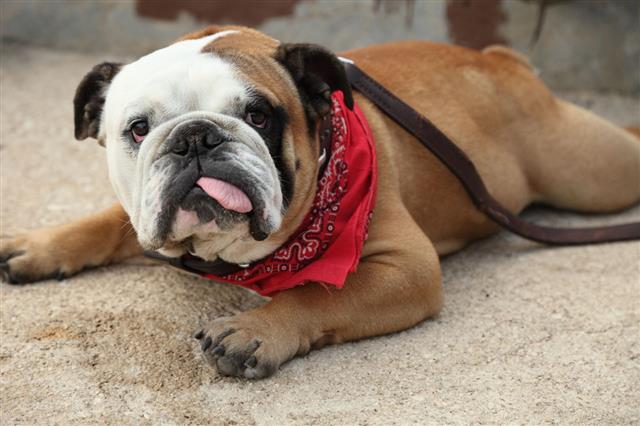
Paralysis is a common calamity that befalls on many pet dogs. Paralysis is very rarely a temporary disorder and needs immediate medical attention. This article will help you know more on paralysis in dogs.
Paralysis in dogs can occur due to many reasons, due to the age of the dog, dog breed, nerve damage, degenerative disks, tics, bacterial or viral infections, etc. The most commonly affected areas are the hind legs. The body functions normally from the spinal cord injury upwards, but becomes paralyzed down from the point of damage or injury.
Although, paralysis is mostly a permanent disorder, proper management of this condition can help reduce the stress and pain, the dog may be suffering from. The following causes are commonly observed:-
Facial Nerve Paralysis
The abnormality of the facial nerve (the 7th cranial nerve) leads to improper functioning of the muscles that are associated with the facial expressions, and this condition is known as the facial nerve paralysis. The causes are idiopathic in most cases. The inflammation of the otitis media-interna (inner and middle ear) is the most common causative factor. The other factors that lead to facial paralysis, is any trauma, surgery of the ear, neuromuscular diseases, cancer or inflammatory diseases affecting the central nervous system of the dog. A dog suffering from facial paralysis exhibits the following symptoms:
- Inability to blink
- Discharge and irritation in the eye
- Lips drooping
- The food is dropped from the mouth
- Excessive salivation
- Dropping of ears when in upright ear conformation
- Tilting of head
- The pupil size becomes asymmetrical
- Uncoordinated gait or Ataxia
- Generalized weakness
- Nystagmus, that is, abnormal movement of the eye
- The orbital fissures show asymmetry, that is, one eye appears larger than the other.
There is no specific treatment available to cure facial nerve this canine problem. The vet may be able to treat the underlying disease that led to this paralysis in dogs. An eye lubricant may be advised to avoid corneal damage. You should administer all the medications and ophthalmic lubricants advised by the vet, to minimize any further complications. Paralysis of the facial nerves is commonly observed in Cocker Spaniels. Proper ear care is advised to minimize the chances of facial nerve paralysis.
Ischemic Myelopathy
The spinal cord requires permanent and non-stop blood supply to carry out the various functions it does, just like any other organ of the body. Arteries supply blood to the spinal cord and any blockage in the artery may result in stopping the blood supply to the specific region of the spinal cord. This blockage or Aortic embolus, may be due to a tumor, fat or fibrocartilaginous fragment of the intervertebral disc. Ischemic myelopathy is the main reason for acute paralysis. This condition can lead to back leg paralysis in dogs, on either side or both sides, depending on the portion of spinal cord affected.
Ischemic myelopathy in dogs has no specific treatment. It is possible that many dogs recover within a few weeks, as soon as they regain the ability to feel pain in their feet. Complete paralysis may take a couple of weeks to improve or the dog may never recover. This is a type of sudden paralysis in dogs that may not exhibit any symptoms and may take about 24 hours to completely immobilize the dog.
Degenerative Disk Disease
The rubber-like cushions between the vertebrae allow the bones in the back to move up, down and sideways. The disk is made of two parts, the outer thick shell-like covering of tough fibers and the central part with a consistency of thick toothpaste. The degeneration of the outer shell, causes the disk to rupture. This is a spontaneous effect known as degenerative disk disease and affects dogs of different breeds, like Dachshunds, Poodles, Pekingese, Lhasa Apso and Cocker Spaniels. There is a low incidence of this disease in dog breeds like German Shepherds and Doberman Pinscher. Degeneration occurs gradually, causing a lot of pain to the dog. The dog becomes reluctant to move and lies in one place for few days to allow the body to heal itself. Degenerative disk disease may cause total paralysis in some dogs within an hour or some dogs may be able to walk around normally.
This disease occurs in stages with different repercussions, as the stages advance. In stage I the dog may feel pain which may get healed by itself. In stage II, there is severe pain in the lumbar and neck region. Stage III leads to partial paralysis with an uncoördinated gait of the dog. Stage IV causes paralysis in dogs, without losing the ability feel. Stage V is the advanced stage with complete paralysis in dog and total loss of feeling. These stages vary from dog to dog and the advancement may take a few hours to few days. Anti-inflammatory drugs, pain killers or surgery may be advised to treat degenerative disk disease.
Tick Paralysis in Dogs
A dog infected with the Dermacentor tick found in America, can fall prey to paralysis. This is because the female ticks have a neurotoxin in their saliva, that leads to tick paralysis in dogs. The symptoms are:
- Loss of control of throat and voice box
- Regurgitation and vomiting
- With the progression of disease, back leg paralytic phase is observed.
- The weakness or paralysis spreads from the spine towards the head.
- There is complete paralysis at the later stage, leading to respiratory problems.
You should take good care regarding the hygiene of your dog and use anti-tick products to keep your dog tick free. Consult the vet regarding the various available options to keep ticks away. The best way to prevent paralytic attack in the hind legs is to carry out a monthly flea and tick treatment for your dog.
Bacterial and Viral Infections in Dogs
Meningitis is the most common bacterial infection that causes back leg paralysis. Rabies and distemper are viral diseases that lead to inflammation of the brain and cause hind leg paralysis in dogs. Discospondylitis is another bacterial or viral disease that affects the spinal bones. If you observe vomiting, fever or respiratory disorders in your dog, consult a vet immediately and take proper treatment to prevent paralysis.
Canine Degenerative Myopathy
The disease of the bone marrow or spinal cord of the dog is called degenerative myopathy. This condition can affect any dog irrespective of age or breed. The exact cause of this condition is unknown but thought to be a genetic mutation. The disease affects the central nervous system, cervical and lumbar regions of spine. In some cases, brain neurons are also affected. It leads to:
- Increase in muscle atrophy
- Inability to maintain posture
- Incontinence (loss of bladder and bowel control)
- Exaggerated spinal reflexes
- Decrease in muscle mass
- Paralysis
The dog is paralyzed within 6 to 10 months after initial diagnosis of the disease. The dog can no longer walk on his own and needs help to turn over when sleeping. Thus, one observes skin lesions due to bed sores. Supportive care is the only treatment available for this debilitating condition. In some cases, exercise helps in delaying spinal cord and other limb atrophy.
Paralysis in dogs rear legs, face, front legs and throat can occur to many diseases and conditions. Some of these conditions are mentioned in the following list:
- Fibrocartilaginous embolism
- Intervertebral disc disease
- Polymyositis
- Polyneuritis
- Embolus
- Malformation of the spine or vertebrae
- Injury to spine
- Hypothyroidism
- Myasthenia gravis
If your observe your dog walking slow, having trouble sitting or standing, excessive drooling, pain when a particular limb is touched, please visit the veterinarian immediately. Prompt medical attention may help prevent paraplegia in dogs.
An owner with a paralytic dog needs to be patient and understanding with the suffering animal. This is the time when your best friend really, really needs your support. Just as your dog loved you selflessly in his good days, this is the time for you to give back the love you received. You have always treated your dog as a part of family, continue taking care of a paralytic dog just as you would for a human family member. Make sure you feed him regularly, help him when he needs to urinate and defecate, give his medications on time and take him for his regular physical therapy and exercises. As the dog has always given you his commitment and dedication, do not feel weary of showering your affection and support, on your loyal and faithful paralytic pet.










